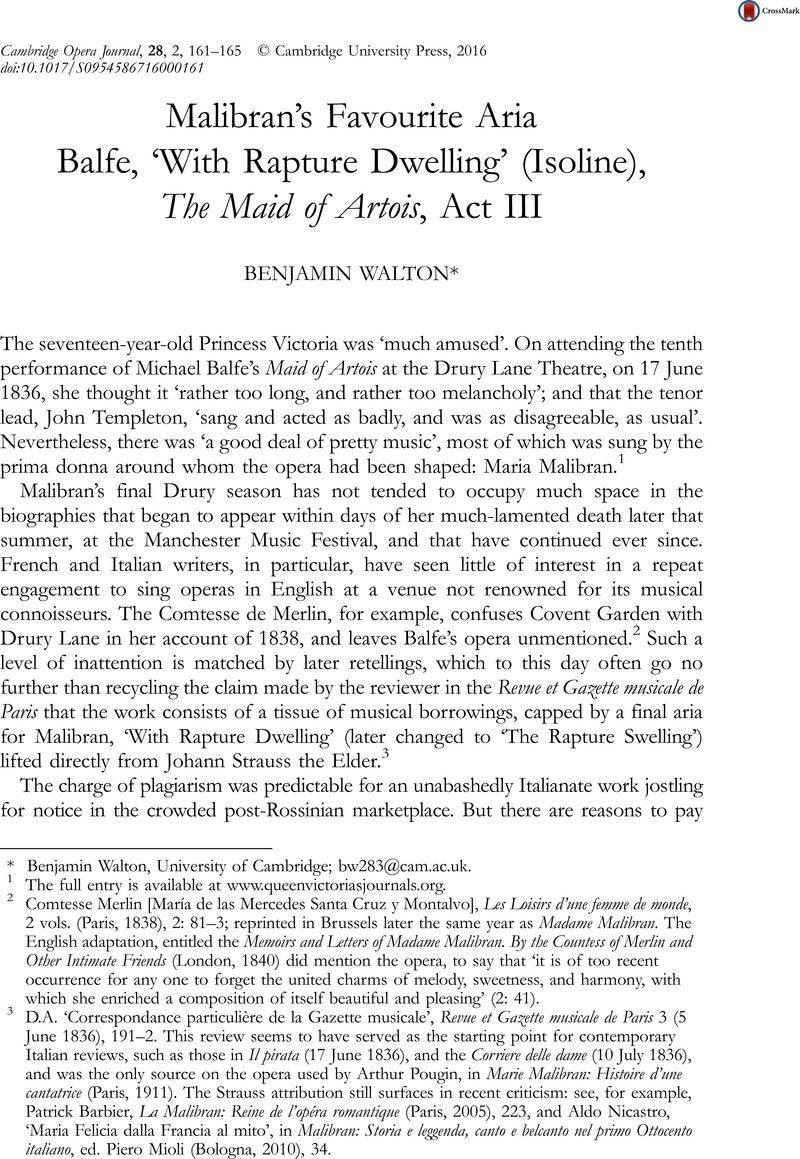No CrossRef data available.
Published online by Cambridge University Press: 28 September 2016

Benjamin Walton, University of Cambridge; [email protected].
1 The full entry is available at www.queenvictoriasjournals.org.
2 Merlin, Comtesse [María de las Mercedes Santa Cruz y Montalvo], Les Loisirs d’une femme de monde, 2 vols. (Paris, 1838), 2: 81–83 Google Scholar; reprinted in Brussels later the same year as Madame Malibran. The English adaptation, entitled the Memoirs and Letters of Madame Malibran. By the Countess of Merlin and Other Intimate Friends (London, 1840) did mention the opera, to say that ‘it is of too recent occurrence for any one to forget the united charms of melody, sweetness, and harmony, with which she enriched a composition of itself beautiful and pleasing’ (2: 41).
3 , D.A. ‘Correspondance particulière de la Gazette musicale’, Revue et Gazette musicale de Paris 3 (5 June 1836), 191–192 Google Scholar. This review seems to have served as the starting point for contemporary Italian reviews, such as those in Il pirata (17 June 1836), and the Corriere delle dame (10 July 1836), and was the only source on the opera used by Pougin, Arthur, in Marie Malibran: Histoire d’une cantatrice (Paris, 1911)Google Scholar. The Strauss attribution still surfaces in recent criticism: see, for example, Barbier, Patrick, La Malibran: Reine de l’opéra romantique (Paris, 2005), 223 Google Scholar, and Nicastro, Aldo, ‘Maria Felicia dalla Francia al mito’, in Malibran: Storia e leggenda, canto e belcanto nel primo Ottocento italiano, ed. Piero Mioli (Bologna, 2010), 34 Google Scholar.
4 The Times (28 May 1836); [Hezekiah Hartley Wright], Desultory Reminiscences of a Tour Through Switzerland, and France (Boston, 1838), 332.
5 , L.A.L., The Bijou Almanack for 1837 (London, 1836)Google Scholar.
6 The anecdote is recorded in Kenney, Charles Lamb, A Memoir of Michael William Balfe (London, 1875), 118 Google Scholar. The aria appeared in various arrangements at the time and afterwards; its fame in St Petersburg would have come from the version by the imperial court pianist, Adolf von Henselt, which he published in 1846 as the fifth of his Op. 13 Concert Etudes, titled ‘Air de Balfe’.
7 Balfe, ‘Favorit-Arie der Malibran’, arranged for oboe and orchestra (or piano) by Ludwig Klemcke (1895).
8 Both libretto (published in 1836) and vocal score (published after Malibran’s death) include only the main musical numbers; the manuscript full score is held at the British Library, Add. MS. 29327 and 29328.
9 White], [Patrick Frederick, ‘Madame Bishop’, in The Emerald Wreath (Dublin, 1852), 102 Google Scholar.
10 ‘Theatrical Examiner. Drury Lane’, The Examiner (5 June 1836). In the original score, the trill in fact comes on a high B rather than a C.
11 ‘The Drama. Drury-Lane Theatre’, Musical Library. Monthly Supplement (July 1836), 108.
12 Manning, Céline Frigau, ‘Playing with Excess: Maria Malibran as Clari at the Théâtre Italien’, in Art, Theatre, and Opera in Paris, 1750–1850, ed. Sarah Hibberd and Richard Wrigley (Farnham, 2014), 203–222 Google Scholar.
13 ‘Theatrical Examiner. Malibran’, The Examiner (2 October 1836); (italics in original).
14 Janin, ‘Mort de Madame Malibran’, Revue et Gazette Musicale de Paris 3 (2 October 1836). In the wake of her death, various authors linked Malibran’s trilled high C to her demise. Henry Phillips, who played the part of the Marquis opposite Malibran at Drury Lane, specifically recalled her trill in the Act III finale as ‘one of the most extraordinary vocal efforts I ever heard’, but adds that she ‘did it so vigorously that I fear it accelerated her death’ ( Phillips, , Musical and Personal Recollections During Half a Century, 2 vols. (London, 1864), 1: 219 Google Scholar). The same high C crowned the performance of Mercadante’s duet ‘Vanne se alberghi in petto’ that led to her final collapse in Manchester.
15 Kenney, Memoir, 117–20.
16 Merlin, Memoirs and Letters, 2: 62; the anecdote seems to have come from Lord William Pitt Lennox, and is repeated in his Fifty Years’ Biographical Reminiscences, 2 vols. (London, 1863), 2: 206–7.
17 Bunn, Alfred, The Stage: Both Before and Behind the Curtain, 3 vols. (London, 1840), 2: 68–70 Google Scholar; Bunn claims that at later performances the same amount of porter was moved to a gourd held by a slave in the retinue of the Marquis, and administered to her on his arrival in the desert.
18 As Mary Novello reported in her reminiscence of Malibran’s final days, rumours were circulating in Manchester suggesting that the singer had a drink problem. ‘They say I drink’, she reports Malibran telling her, ‘but should I have kept my voice and appearance with all the fatigue I have gone through, had I done so?’ See ‘The Last Days of Madame de Bériot’, The Musical World (14 October 1836), 70.
19 Browne, Lennox, Voice Use and Stimulants (London, 1885), 49 Google Scholar.
20 Weir, W., ‘Beer’, in London, ed. Charles Knight, 6 vols. (London, 1841–4), 4 Google Scholar: 3.
21 Weir, ‘Beer’, 4: 16.